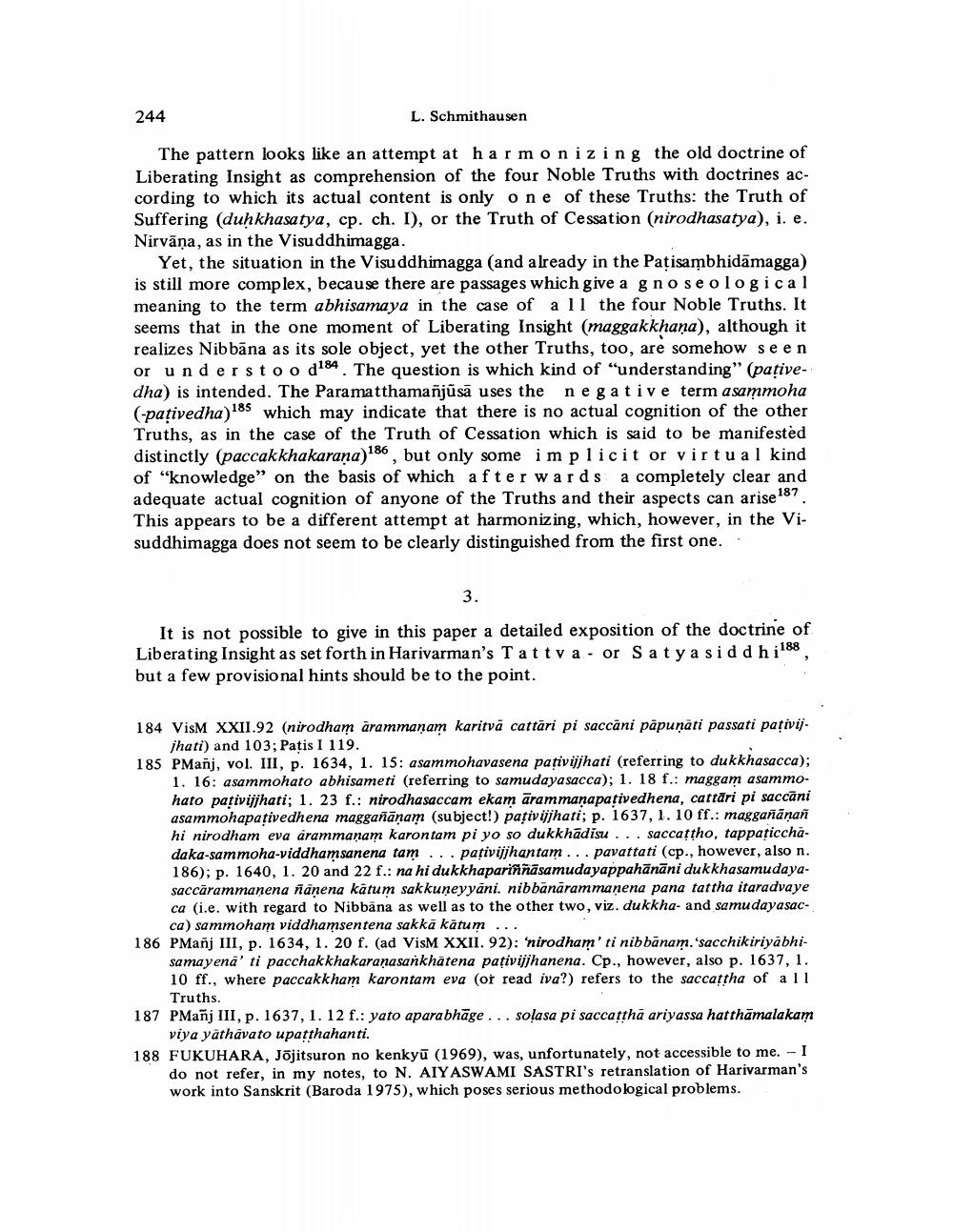________________
244
L. Schmithausen
The pattern looks like an attempt at harmonizing the old doctrine of Liberating Insight as comprehension of the four Noble Truths with doctrines according to which its actual content is only one of these Truths: the Truth of Suffering (duh khasatya, cp. ch. I), or the Truth of Cessation (nirodhasatya), i. e. Nirvāna, as in the Visuddhimagga.
Yet, the situation in the Visuddhimagga (and already in the Patisambhidāmagga) is still more complex, because there are passages which give a gnoseological meaning to the term abhisamaya in the case of a 11 the four Noble Truths. It seems that in the one moment of Liberating Insight (maggakkhana), although it realizes Nibbāna as its sole object, yet the other Truths, too, are somehow seen or understood184. The question is which kind of "understanding" (pațivedha) is intended. The Paramatthamanjūsā uses the negative term asammoha (-pativedha) 185 which may indicate that there is no actual cognition of the other Truths, as in the case of the Truth of Cessation which is said to be manifested distinctly (paccakkhakarana)186, but only some implicit or virtual kind of "knowledge on the basis of which afterwards a completely clear and adequate actual cognition of anyone of the Truths and their aspects can arise 187. This appears to be a different attempt at harmonizing, which, however, in the Visuddhimagga does not seem to be clearly distinguished from the first one..
It is not possible to give in this paper a detailed exposition of the doctrine of Liberating Insight as set forth in Harivarman's Tattva - or Satya siddh i188, but a few provisional hints should be to the point.
184 VisM XXII.92 (nirodham ārammanam karitvă cattāri pi saccani päpunāti passati pațivij
jhati) and 103; Patis I 119. 185 PManj, vol. III, p. 1634, 1. 15: asammohavasena pativijihati (referring to dukkhasacca);
1. 16: asammohato abhisameti (referring to samudaya sacca); 1. 18 f.: maggam asammohato pațivijihati; 1. 23 f.: nirodhasaccam ekam ārammanapativedhena, cattāri pi saccani asammohapațivedhena magganānam (subject!) pațivijjhati; p. 1637, 1. 10 ff.: maggañānañ hi nirodham eva arammanam karon tam pi yo so dukkhadisu ... saccattho, tappaticchadaka-sammoha-viddhamsanena tam... pativijjhantam... pavattati (cp., however, also n. 186); p. 1640, 1. 20 and 22 f.: na hi dukkhaparinnasamudayappahānāni dukkhasamudayasaccārammanena nanena katum sakkuneyyani. nibbanārammanena pana tattha itaradvaye ca (i.e. with regard to Nibbana as well as to the other two, viz. dukkha. and samudayasac
ca) sammoham viddhamsentena sakka kätum ... 186 PManj III, p. 1634, 1. 20 f. (ad VisM XXII. 92): nirodham'ri nibbānam. 'sacchikiriyabhi
samayena' ti pacchakkhakaranasankhatena pațivijjhanena. Cp., however, also p. 1637, 1. 10 ff., where paccakkham karontam eva (of read iva?) refers to the saccattha of a 11
Truths. 187 PManj III, p. 1637, 1. 12 f.: yato aparabhāge ... solasa pi saccatthå ariyassa hatthāmalakam
viya yathāvato upatthahanti. 188 FUKUHARA, Jõjitsuron no kenkyū (1969), was, unfortunately, not accessible to me. - I
do not refer, in my notes, to N. AIYASWAMI SASTRI's retranslation of Harivarman's work into Sanskrit (Baroda 1975), which poses serious methodological problems.




